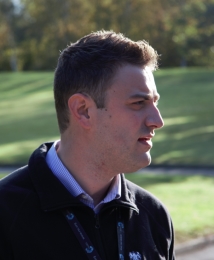THEME IV – Neurotoxins and high toxicity agents
Overview
This Theme involves understanding significant chemical hazards to human health, ranging from household pollutants to toxic industrial chemicals (TICs) and chemical warfare agents (CWA). In brief, the cycle of environmental toxic agents starts from i) its presence in the environment; ii) its direct contact with humans; iii) its absorption by the body followed by the physiological process of its toxicity; and iv) its clearance from the body.
The research in this Theme focuses on elucidating the mechanisms of action, presence in the environment, impact at the cellular level, defining decontamination protocols and developing novel routes to decomposition/disruption. A key aspect is the impact of such chemicals on humans, and how to decontaminate or alleviate exposure.

Theme Leads
Dr Nora Bourbia

Theme 4 Co-Lead
UK Health Security Agency
CRTH Projects:
Theme 4 Project 1: Novel screens for environmental neurotoxins
Research Areas:
After obtaining a Master’s degree in cellular and integrative neuroscience at University of Strasbourg (France) and a PhD in medicine in the field of neurophysiology of pain at University of Helsinki (Finland), Nora moved to the UK as a post-doc in neurobehavioural genetics at the MRC Harwell (UK) and then joined PHE (now UKHSA) to lead the Neurobiology group.
Throughout my academic journey I was interested by the field of neuroepigenetics. How and why adult on-set of neurological/neuropsychiatric disorders start? At which moment and how the brain cells trigger a succession of events that cascade to neuronal loss and memory decline in neurodegenerative disorders? How life events trigger depression and affective disorders in adults? How environmental hazards induce the switch from a healthy to a pathological neuron? To address these questions, I have followed an academic path to learn skills in animal behaviour, electrophysiology, biochemistry and genetics to implement them in our group and investigate the effects of environmental hazards on the epigenetics of brain disorders.
Publications:
Professor Tom Welton

Theme 4 Co-Lead
Imperial College London
CRTH Projects:
Theme 4 Project 4: Clearance of neurotoxins and other highly toxic chemicals from the environment
Publications:
Theme IV Projects
Project outline: Most brain disorders (including neurological and neuropsychological disorders and diseases such as Alzheimer’s Disease, Parkinson’s Disease, Bipolar disorder, depression, multiple sclerosis, chronic pain) are multifactorial involving genetic and environmental aspects. Because environmental factors have an impact on the establishment and maintenance of brain disorders, the investigation of these environmental neurotoxins will help to prevent or reverse their negative effects on brain health.
Overall objectives: This study will contribute to the overall ambition of protecting and maintaining good mental health and therefore reducing the economic burden on society. We aim to i) study the impact of nitric oxide / nitrite / nitrate on the endogenous nitric oxide pathway of brain cells; ii) study the impact of mycotoxins on brain cell activity; iii) develop an assay to screen the effect of environmental agents on the electrical properties of neurons.
Project outline: Human decontamination is critical following release of toxic chemicals and simulants are often used to assess decontamination procedure efficacy. To date, simulants employed in these studies are typically hydrophobic, volatile liquids at ambient conditions and the majority of studies have used a single chemical simulant (methyl salicylate). Another concern is the use of highly toxic powders which may require different decontamination approaches to the liquids utilised in all human decontamination studies to date.
Overall objectives: To provide evidence to support modifications to existing operational response to improve the efficacy of chemical mass casualty decontamination with respect to toxic powders and liquids. We will identify and evaluate novel simulants that address the spectrum of physicochemical properties of toxic chemicals, including novel and priority threats. This will involve a literature search for suitable low toxicity agents that have been applied to skin, are absorbed sufficiently to enable quantitation in urine and that mimic the physicochemical characteristics of toxic industrial chemicals/threat agents.
Project outline: Identification and monitoring of potentially hundreds of new highly toxic agents (HTAs) in drinking water arising from by-products of chemical treatment processes (e.g. disinfection) and contamination with chemical substances (e.g. pharmaceuticals, pesticides, organometallics, plastic-related compounds, etc.) remains a significant challenge. Analytical methods involving ion chromatography, liquid chromatography and comprehensive gas chromatography coupled to full-scan high resolution mass spectrometry (HRMS) instruments will be developed and validated for several main classes of currently known compounds including plasticisers, disinfectant by-products (haloacetic acids, oxyhalides, trihalomethanes), pesticides (herbicides, insecticides, rodenticides, etc.), pharmaceuticals and illicit drugs (focussing on those which survive wastewater treatment). Full-scan measurement data for these ‘model’ compounds will then be used to construct machine learning-based prediction models to assist in identification of new HTA substances.
Overall objectives: This project will characterise and classify new chemical HTAs in UK municipal, well and bottled drinking waters and assess their potential risks for human exposure. The objectives of the project are to i) develop AI-assisted high resolution analytical methods for screening of large numbers of suspect neurotoxins and HTA markers; ii) conduct a temporal survey of drinking water sources across the UK; iii) analyse urine samples to assess individual-level exposure and analyse wastewater from the corresponding city to extrapolate to both human population and environmental exposure; iv) evaluate public health and environmental risk of HTAs from drinking water sources.
Project outline: Detection of and protection from CWAs have become more urgent with recent events. Agents can be highly volatile and non-persistent (e.g. sarin) or have lower volatility and only partial water solubility creating more persistent hazards (e.g. mustard gases). New systems that can be used to safely clear CWAs from the environment are urgently required. Ionic Liquids (ILs) are efficient in detecting and absorbing gases and liquids present in low concentrations. Selected ILs also suppress solute vapour production. ILs have also been shown to accelerate the rates of chemical reactions, so providing the possibility to enhance decomposition of CWA but our understanding of these mechanisms is lacking.
Overall objectives: We will seek to understand how ionic liquid-solute interactions can be manipulated to create solutions for the detection and destruction of CWAs. We will combine computational and experimental techniques to i) identify the mechanism of solvation and decomposition of CWA in known ILs; ii) investigate solvation and decomposition of common CWA simulants, evaluate simulant fidelity against real CWA chemical structures, solvation and degradation processes, and identify better potential simulants, and their key chemical features; iii) design and test in silico novel ILs with simulants and CWA to improve containment and facilitate analytical processing; iv) design and test in silico novel ILs with simulants and CWA to enhance decomposition rates and promote generation of nontoxic degradation products.
Project outline: The early identification of illicit manufacture of threat agents is critical for protection of public safety. The aim of this work is to identify markers that exist and/or that can be added to both explosives (E) and chemical (C) threat precursors to identify synthesis via wastewater. Markers should be non-volatile, inert and not be prevalent in wastewater. The focus lies on improvised explosives (e.g., peroxides and inorganics) and nerve agents/mimics. The project integrates the latest advances in high-resolution analysis and in silico AI-assisted technologies to rapidly achieve this. Ultimately, the outcomes of this project will provide a much-needed baseline reference point for discrete monitoring of threat agent manufacturing activity on a city-wide level.
Overall objectives: i) to review and compile a list of ingredients within a range of commercially available C/E-threat precursor products; ii) to identify reactive precursor impurities under clandestine manufacturing conditions and predict their identities or chemical products; iii) to perform targeted and untargeted screening of selected precursor materials to identify common markers for manufacture of specific C/E threats; iv) to screen for the presence of all identified markers in municipal wastewater; v) to understand the stability of C/E threat markers to enable reliable back-calculation of production load in kg/day in a catchment.
Theme IV Investigators
Dr Leon Barron

Investigator
Environmental Research Group, School of Public Health, Imperial College London
CRTH Projects:
Theme 2 Project 2: Pathways and biomarkers of mixtures of chemical exposures
Theme 2 Project 3: Biomarkers of potential exposures from brownfield sites
Theme 4 Project 1: Novel screens for environmental neurotoxins
Theme 4 Project 3: Detection of HTAs in water
Publications:
Dr Nora Bourbia

Theme 4 Co-Lead
UK Health Security Agency
CRTH Projects:
Theme 4 Project 1: Novel screens for environmental neurotoxins
Research Areas:
After obtaining a Master’s degree in cellular and integrative neuroscience at University of Strasbourg (France) and a PhD in medicine in the field of neurophysiology of pain at University of Helsinki (Finland), Nora moved to the UK as a post-doc in neurobehavioural genetics at the MRC Harwell (UK) and then joined PHE (now UKHSA) to lead the Neurobiology group.
Throughout my academic journey I was interested by the field of neuroepigenetics. How and why adult on-set of neurological/neuropsychiatric disorders start? At which moment and how the brain cells trigger a succession of events that cascade to neuronal loss and memory decline in neurodegenerative disorders? How life events trigger depression and affective disorders in adults? How environmental hazards induce the switch from a healthy to a pathological neuron? To address these questions, I have followed an academic path to learn skills in animal behaviour, electrophysiology, biochemistry and genetics to implement them in our group and investigate the effects of environmental hazards on the epigenetics of brain disorders.
Publications:
Professor Marc Chadeau-Hyam

Theme 2 Co-Lead
School of Public Health, Imperial College London
CRTH Projects:
Theme 2 Project 2: Pathways and biomarkers of mixtures of chemical exposures
Theme 4 Project 3: Detection of HTAs in water
Publications:
Mr Davide Ciccarelli
PhD Student
School of Public Health, Imperial College London
CRTH Projects:
Theme 4 Project 3: Detection of HTAs in water
Publications:
Professor Patricia Hunt

Investigator
Imperial College London
CRTH Projects:
Theme 4 Project 4: Clearance of neurotoxins and other highly toxic chemicals from the environment
Publications:
Mr Tom James

PhD Student
UK Health Security Agency
Research Areas:
Thomas is a Health Protection Scientist and analytical chemist for UKHSA with five years’ experience in mass casualty decontamination. He’s worked alongside multiple government agencies assisting in the provision of analytical evidence for the efficacy of decontamination interventions through multiple human trials and exercises. He has an MSc in analytical chemistry from the University of South Wales and is currently studying for a PhD with the Open University on the decontamination of novel chemical agents, funded through the NIHR HPRU in Chemical and Radiation Threats and Hazards.
Publications:
Dr Tim Marczylo

Investigator
UK Health Security Agency
Research Areas:
Dr Tim Marczylo Ph.D., B.Sc. is a principal toxicologist and leads a small team within the Toxicology Department at the Centre for Radiation, Chemical and Environmental Hazards, UKHSA. His main research focus is on the exposure of the public to potentially damaging environmental toxicants and their health consequences. Recently, research has focussed on biomarkers of electronic cigarette exposure and on evaluating mass casualty decontamination strategies.
Publications:
Dr Keng Tiong Ng

Investigator
Environmental Research Group, School of Public Health, Imperial College London
CRTH Projects:
Publications:
Dr Charles Romain

Investigator
Imperial College London
CRTH Projects:
Theme 4 Project 4: Clearance of neurotoxins and other highly toxic chemicals from the environment
Publications:
Dr Peter Thompson

Investigator
National Physical Laboratory
CRTH Projects:
Publications:
Professor Paolo Vineis

Investigator
School of Public Health, Imperial College London
CRTH Projects:
Theme 2 Project 2: Pathways and biomarkers of mixtures of chemical exposures
Theme 4 Project 3: Detection of HTAs in water
Publications:
Gavin Smith
PhD Student
School of Public Health, Imperial College London
CRTH Projects:
Theme 4 Project 4: Clearance of neurotoxins and other highly toxic chemicals from the environment
Publications:
Professor Tom Welton

Theme 4 Co-Lead
Imperial College London
CRTH Projects:
Theme 4 Project 4: Clearance of neurotoxins and other highly toxic chemicals from the environment
